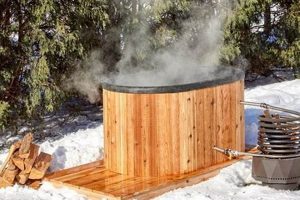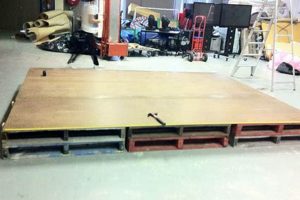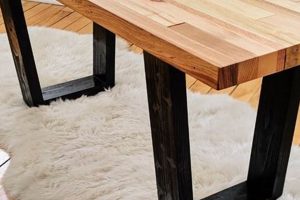The construction of wooden surfaces for food preparation areas, achieved through individual effort rather than professional installation, represents a specific segment within home improvement projects. These surfaces, typically fashioned from hardwoods or reclaimed lumber, offer a customized and often cost-effective alternative to manufactured materials. An example is a homeowner selecting maple boards, joining them, and applying a food-safe finish to create a durable and aesthetically pleasing area for kitchen tasks.
The appeal of such endeavors lies in several advantages. This includes cost savings when compared to professional installations of stone or synthetic materials. Further benefits are the ability to personalize dimensions, wood species, and finishing details to complement the overall kitchen design. Historically, wood has been a traditional material for surfaces in food preparation areas, valued for its workability and natural aesthetic. This tradition endures, now enhanced by modern sealing and finishing techniques that improve durability and sanitation.
Understanding wood selection, fabrication techniques, finishing processes, and ongoing maintenance are essential elements in successfully creating a functional and visually appealing wooden surface for food preparation. Subsequent sections will delve into these aspects in greater detail, providing a comprehensive overview of the key considerations for achieving optimal results.
Essential Guidance for Wooden Kitchen Surfaces Crafted at Home
Effective creation of wooden surfaces for food preparation requires careful planning and meticulous execution. The following tips outline crucial considerations for ensuring a durable, safe, and aesthetically pleasing result.
Tip 1: Material Selection is Paramount: Choose hardwoods like maple, oak, or walnut for their density and resistance to wear. Softwoods are generally unsuitable due to their susceptibility to damage. Ensure the wood is kiln-dried to minimize warping or cracking.
Tip 2: Accurate Measurement and Planning are Critical: Develop a detailed plan with precise measurements of the intended surface area. Account for overhangs, sink placement, and appliance clearances. This ensures efficient material use and minimizes waste.
Tip 3: Prioritize Proper Jointing Techniques: Employ robust jointing methods like butt joints with biscuits or mortise and tenon joints to ensure structural integrity. Inadequate jointing can lead to instability and premature failure.
Tip 4: Sanding is Essential for a Smooth, Safe Surface: Progress through multiple sanding grits, starting with a coarse grit (e.g., 80) and finishing with a fine grit (e.g., 220). This eliminates imperfections and creates a smooth surface that is easily cleaned and resists staining.
Tip 5: Select a Food-Safe Finish: Apply a food-safe finish specifically designed for surfaces in contact with food. Options include mineral oil, beeswax, or specialized varnishes. Follow the manufacturer’s instructions for application and curing times.
Tip 6: Apply Multiple Coats of Finish: Apply several thin coats of the chosen finish, allowing each coat to dry completely before applying the next. This creates a durable, protective barrier against moisture and stains.
Tip 7: Ensure Proper Sealing Around Sinks and Appliances: Use a waterproof sealant around sinks and appliances to prevent water damage. Regularly inspect the sealant and reapply as needed.
Careful execution of these steps results in a functional and visually appealing addition to the kitchen. Adherence to these guidelines promotes longevity and enhances the overall value of the project.
The subsequent section will address the maintenance and care required to preserve the integrity and appearance of the newly created wooden surface.
1. Wood species selection
The choice of wood species is a foundational decision in the creation of wooden surfaces for food preparation, directly influencing the durability, aesthetics, and longevity of the finished product. This selection transcends mere visual preference; it involves a critical assessment of inherent wood properties and their suitability for a demanding kitchen environment.
- Hardness and Durability
Hardness, measured by the Janka hardness scale, is a crucial factor. Harder woods, such as maple and oak, resist scratching and denting more effectively than softer woods like pine or fir. This directly impacts the surface’s ability to withstand daily use, cutting, and impact from kitchen utensils. The choice of a softer wood may necessitate more frequent refinishing or replacement.
- Grain Pattern and Aesthetics
Different species exhibit distinct grain patterns, influencing the visual appeal. Maple offers a subtle, uniform grain, while oak displays a more pronounced and textured pattern. Walnut provides a rich, dark tone and complex grain. The selected grain pattern should align with the overall kitchen design and the desired aesthetic. Consider whether a consistent, understated look or a more visually dynamic surface is preferred.
- Moisture Resistance and Stability
Wood is inherently susceptible to moisture absorption, which can lead to warping, cracking, or swelling. Denser hardwoods generally exhibit better moisture resistance and dimensional stability than softwoods. Kiln-drying wood prior to fabrication further reduces moisture content, minimizing the risk of these issues. Proper sealing and finishing are also essential to protect the wood from water damage.
- Cost and Availability
The cost and availability of different wood species vary considerably. Exotic hardwoods can be significantly more expensive and difficult to source than domestically available options. Balancing cost considerations with desired properties is essential. Local availability may also influence the final selection, especially for projects prioritizing sustainable sourcing.
The careful evaluation of wood species ensures the creation of a durable, aesthetically pleasing, and functional surface for food preparation. Selecting the appropriate species is not merely a cosmetic choice but a fundamental decision affecting the long-term performance and value of the finished project.
2. Joint Strength
Within the context of wooden surfaces for food preparation crafted through individual effort, joint strength constitutes a critical determinant of structural integrity and longevity. The process of uniting individual wooden components to form a continuous surface inevitably introduces points of potential weakness. The method employed to join these sections directly impacts the surface’s capacity to withstand daily use, weight bearing, and the stresses induced by environmental fluctuations. Inadequate joint strength can manifest as warping, separation, or catastrophic failure of the structure. For instance, a surface constructed with simple butt joints and insufficient adhesive may rapidly degrade under the repeated impact of food preparation activities.
Various jointing techniques offer differing levels of strength and complexity. Mortise and tenon joints, dovetail joints, and biscuit joints represent successively robust options, each requiring specific tools and expertise. The selection of a jointing method should consider the anticipated load, the wood species employed, and the overall dimensions of the structure. For example, a large island surface, subjected to significant weight and frequent use, demands more substantial jointing methods than a small, lightly used surface. Furthermore, the correct application of adhesives and clamping pressure during the jointing process is paramount to achieving optimal bond strength. Deviations from recommended procedures can significantly compromise the integrity of even the most robust joint design.
The significance of joint strength in the creation of wooden surfaces for food preparation lies in its direct correlation with the surface’s functional lifespan and safety. Prioritizing appropriate jointing techniques, coupled with meticulous execution, mitigates the risk of structural failure, ensuring a durable and reliable food preparation area. A well-constructed and properly jointed surface enhances the overall value and usability of the kitchen space, representing a long-term investment in both functionality and aesthetics.
3. Surface Finish
The selection and application of a surface finish are paramount in the creation of wooden surfaces for food preparation, representing the final protective layer that directly impacts the surface’s durability, hygiene, and aesthetic appeal. The chosen finish must provide a barrier against moisture, stains, and bacteria while also enhancing the wood’s natural beauty and ensuring suitability for contact with food.
- Protection Against Moisture and Stains
The primary function of a surface finish is to prevent moisture absorption, which can lead to warping, cracking, and the growth of mold and bacteria. Finishes like polyurethane or specialized wood oils create a water-resistant barrier, preventing liquids from penetrating the wood fibers. This protection also extends to preventing staining from common kitchen spills, such as coffee, wine, or oil. The efficacy of the finish is directly proportional to the number of coats applied and the quality of the product.
- Food Safety and Hygiene
Given the intended use of the surface for food preparation, the selected finish must be demonstrably food-safe. This implies that the finish, once fully cured, does not leach harmful chemicals into food. Natural oil finishes, such as mineral oil or beeswax, are often favored for their non-toxic properties. However, it’s imperative to verify that any finish, regardless of its composition, is explicitly labeled as food-safe by the manufacturer.
- Durability and Maintenance
The surface finish should be sufficiently durable to withstand the rigors of daily use, including cutting, chopping, and cleaning. Finishes vary in their resistance to scratching, abrasion, and heat. Polyurethane finishes, for example, offer excellent durability but may be more challenging to repair. Oil-based finishes, while offering a natural look and easy repairability, may require more frequent reapplication. The choice should reflect a balance between desired aesthetics, ease of maintenance, and expected wear and tear.
- Aesthetic Enhancement
Beyond its functional properties, the surface finish contributes significantly to the visual appeal. Finishes can range from matte to glossy, and they can accentuate or subtly alter the wood’s natural color and grain. Clear finishes preserve the wood’s original appearance, while tinted finishes can add warmth or depth. The choice of finish should complement the overall kitchen design and reflect the desired aesthetic.
Therefore, the selection and meticulous application of a surface finish directly impacts the functionality, hygiene, and aesthetic appeal of wooden surfaces for food preparation. A carefully chosen finish safeguards the wood, ensures food safety, and enhances the overall quality and longevity of the completed surface.
4. Sealing process
The sealing process is an indispensable element in the successful creation and longevity of wooden surfaces for food preparation. It directly mitigates the inherent vulnerabilities of wood to moisture, microbial contamination, and stainingelements that can compromise the structural integrity and hygiene of the surface. An improperly sealed surface is susceptible to water absorption, leading to warping, cracking, and the propagation of bacteria and mold, rendering it unsuitable for food contact. The sealing process thus forms a critical barrier, safeguarding both the material and the users’ health. A typical example is a wooden surface, inadequately sealed around a sink, exhibiting signs of water damage and discoloration within a short period of use.
The selection of appropriate sealing agents and the meticulous application technique are crucial. Food-grade sealants, such as specialized oils and varnishes, are designed to create a non-toxic, water-resistant layer. Multiple coats are often required, ensuring complete coverage and penetration into the wood’s pores. The application process must adhere to manufacturer’s specifications, including proper drying times and environmental conditions, to achieve optimal adhesion and performance. Consider, for instance, the application of multiple thin coats of mineral oil, allowing each coat to fully penetrate and cure before applying the subsequent layer, ensuring a comprehensive sealing effect.
In conclusion, the sealing process represents a critical control point in constructing wooden surfaces for food preparation. Its effectiveness directly influences the surface’s durability, hygiene, and safety. Challenges arise in selecting suitable sealants and implementing proper application techniques, requiring careful consideration of the wood species, the intended use, and available resources. Successful implementation of the sealing process ensures a functional, aesthetically pleasing, and hygienic surface for years to come, contributing significantly to the overall value of the project.
5. Dimensional stability
Dimensional stability, concerning surfaces for food preparation, refers to the ability of wood to maintain its original size and shape despite changes in environmental conditions, specifically temperature and humidity. This characteristic is paramount for the long-term functionality and aesthetic appeal of such surfaces, dictating their resistance to warping, cracking, and general deformation.
- Wood Species Selection and Moisture Content
The species of wood selected and its initial moisture content exert a significant influence on dimensional stability. Hardwoods generally exhibit greater stability than softwoods. Kiln-drying lumber to a specific moisture content (typically between 6% and 8% for interior applications) minimizes subsequent dimensional changes. Wood that has not been properly dried will expand or contract significantly as it equilibrates with the ambient humidity, potentially compromising the integrity of the surface.
- Construction Techniques and Joinery
Construction techniques employed during fabrication play a crucial role. Allowing for wood movement is essential in design and joinery. Using rigid adhesives and tightly fixed joints that restrict natural expansion and contraction can lead to stress buildup and eventual failure. Techniques like floating panel construction or the use of expansion gaps can accommodate dimensional changes without compromising the overall structural integrity.
- Environmental Control and Humidity Management
Maintaining a stable indoor environment minimizes dimensional changes. Significant fluctuations in temperature and humidity, especially during seasonal changes, can induce expansion and contraction cycles. The installation of a whole-house humidifier or dehumidifier can mitigate these effects, preserving the surface’s dimensional stability over time. Consistent humidity control is especially crucial in regions with extreme seasonal climate variations.
- Finishing and Sealing Applications
The application of appropriate finishes and sealants creates a barrier against moisture absorption, further enhancing dimensional stability. Penetrating oil finishes or multiple coats of polyurethane can effectively reduce the rate of moisture exchange between the wood and the surrounding environment. Regular maintenance and reapplication of finishes are necessary to maintain this protective barrier over the lifespan of the surface.
Integrating these considerations into the construction process ensures the surface’s long-term stability. Neglecting these factors can lead to unsightly defects, functional impairment, and premature failure of the kitchen surface. Adherence to these principles directly contributes to the overall value and utility of these surfaces as a functional and aesthetically pleasing element of the kitchen.
6. Maintenance routines
Regular and appropriate maintenance routines are inextricably linked to the long-term performance and aesthetic appeal of wooden surfaces for food preparation. The inherent properties of wood, coupled with the demanding environment of a kitchen, necessitate consistent care to prevent degradation. The causal relationship is direct: neglect of maintenance leads to accelerated wear, staining, microbial growth, and potential structural damage. The importance of these routines lies in their ability to preserve the surface’s functionality, hygiene, and appearance, safeguarding the initial investment of time and materials. For example, a wooden surface left uncleaned after spills can develop permanent stains and harbor bacteria, while a surface not regularly oiled may dry out and crack.
Effective maintenance routines encompass several key practices. Consistent cleaning with mild, food-safe detergents removes food residue and prevents bacterial buildup. Periodic oiling or waxing replenishes the protective barrier, preventing moisture absorption and maintaining the wood’s natural luster. Prompt attention to scratches or minor damage prevents further deterioration and potential contamination. Specialized maintenance procedures may be required depending on the type of finish applied; polyurethane finishes may necessitate occasional refinishing, while oiled surfaces benefit from regular reapplication of oil. The frequency and intensity of these routines depend on the level of usage and the specific characteristics of the wood and finish.
In summary, diligent adherence to appropriate maintenance routines is essential for maximizing the lifespan and preserving the integrity of wooden surfaces for food preparation. While the initial creation involves careful planning and execution, ongoing maintenance is the key to long-term success. The challenges lie in consistently implementing these routines and adapting them to the specific needs of the surface. Recognizing the practical significance of maintenance underscores the importance of viewing it as an integral component of the entire endeavor, rather than an afterthought.
Frequently Asked Questions
The following questions address common inquiries regarding the creation, maintenance, and suitability of wooden surfaces crafted for use in food preparation areas. The responses aim to provide clear and concise information based on best practices and material science.
Question 1: What wood species are best suited for use in surfaces intended for food preparation?
Hardwoods, such as maple, oak, and walnut, are generally preferred. Their density and tight grain structure provide better resistance to scratches, dents, and moisture absorption compared to softwoods like pine or fir. The selected wood should also be kiln-dried to minimize warping and cracking.
Question 2: How can the safety of a finished surface for food contact be ensured?
Employ only finishes explicitly labeled as food-safe by the manufacturer. These finishes, once fully cured, do not leach harmful chemicals into food. Natural oil finishes, such as mineral oil or beeswax, are frequently used, but their food-safe certification should always be verified.
Question 3: What jointing techniques provide the greatest structural integrity for these surfaces?
Mortise and tenon joints and dovetail joints offer superior strength compared to simpler butt joints. Biscuit joints can also provide adequate strength when used in conjunction with a high-quality adhesive. The chosen jointing method should be appropriate for the size and anticipated load on the surface.
Question 4: How can warping and cracking be prevented in wooden surfaces for food preparation?
Starting with kiln-dried lumber is essential. Proper sealing and finishing will minimize moisture absorption. Construction techniques that allow for wood movement, such as floating panel designs, can accommodate dimensional changes. Maintaining a stable indoor environment with consistent humidity levels also helps to prevent warping and cracking.
Question 5: What are the best practices for cleaning a wooden surface used for food preparation?
Regularly clean the surface with a mild, food-safe detergent and a soft cloth. Avoid abrasive cleaners or scouring pads, which can damage the finish. Promptly wipe up spills to prevent staining. Sanitize the surface periodically with a diluted bleach solution, ensuring thorough rinsing and drying afterward.
Question 6: How often should a wooden surface for food preparation be re-oiled or re-waxed?
The frequency depends on the type of finish and the level of use. Surfaces finished with mineral oil or beeswax typically require reapplication every few months or when the surface appears dry. Polyurethane finishes generally require less frequent maintenance, but may need to be refinished if they become scratched or damaged.
Proper material selection, construction techniques, finishing, and maintenance are all necessary for the creation of durable, safe, and aesthetically pleasing surfaces for food preparation. Adherence to these principles maximizes the lifespan and functionality of the surface.
The subsequent section will provide a comparative analysis of different wood species commonly used in surfaces intended for food preparation, further informing the selection process.
DIY Wood Kitchen Countertops
The preceding exploration has elucidated the essential considerations surrounding the construction of wooden surfaces for food preparation. Successful execution of these endeavors requires a thorough understanding of material selection, jointing techniques, finishing processes, and ongoing maintenance. The inherent characteristics of wood necessitate a meticulous approach to ensure structural integrity, food safety, and aesthetic longevity. Improperly executed, a surface may compromise hygiene standards and exhibit premature degradation, negating the intended benefits of cost savings and customization.
The decision to undertake the creation of such surfaces demands careful deliberation. A commitment to rigorous adherence to best practices, coupled with a realistic assessment of available skills and resources, will ultimately determine the project’s success. Recognizing the long-term implications of material choices and construction methods is paramount, ensuring that the finished product serves as a durable and functional component of the kitchen environment for years to come.



![[DIY Guide] Easy DIY Wood Window Shutters You Can Build! The DIY Hub: Creative Crafts, Repairs & Life Hacks [DIY Guide] Easy DIY Wood Window Shutters You Can Build! | The DIY Hub: Creative Crafts, Repairs & Life Hacks](https://craftingdiycenter.com/wp-content/uploads/2025/07/th-3579-300x200.jpg)



